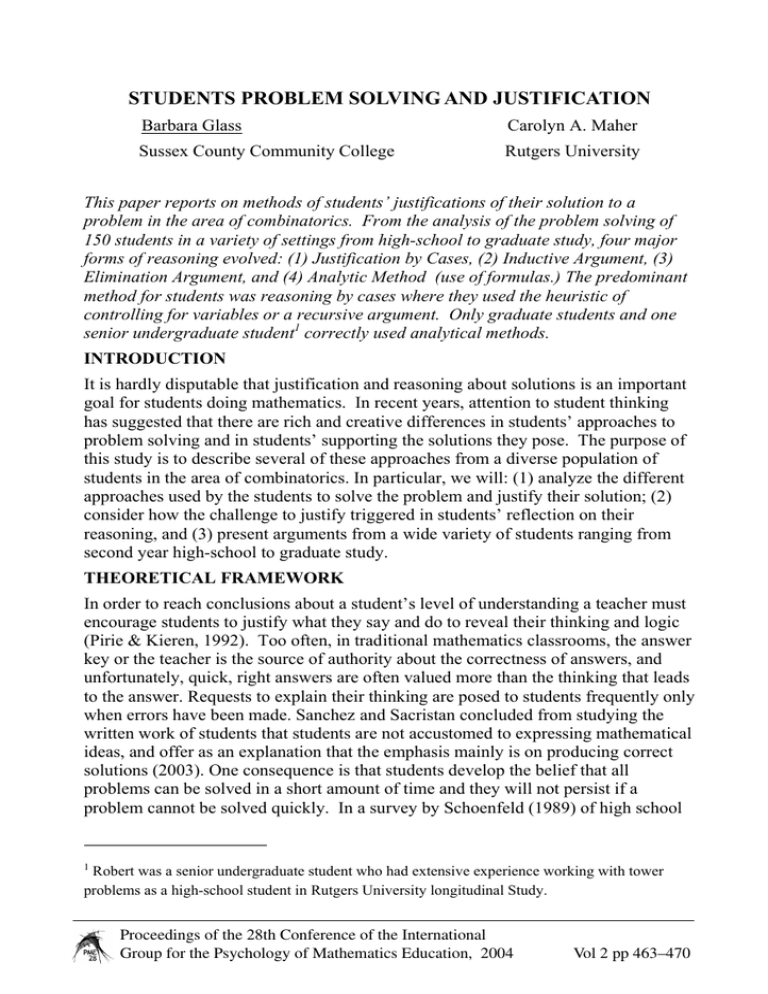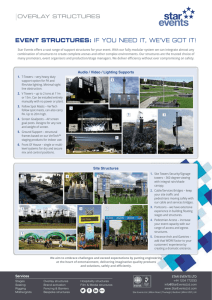STUDENTS PROBLEM SOLVING AND JUSTIFICATION
advertisement

STUDENTS PROBLEM SOLVING AND JUSTIFICATION Barbara Glass Carolyn A. Maher Sussex County Community College Rutgers University This paper reports on methods of students’ justifications of their solution to a problem in the area of combinatorics. From the analysis of the problem solving of 150 students in a variety of settings from high-school to graduate study, four major forms of reasoning evolved: (1) Justification by Cases, (2) Inductive Argument, (3) Elimination Argument, and (4) Analytic Method (use of formulas.) The predominant method for students was reasoning by cases where they used the heuristic of controlling for variables or a recursive argument. Only graduate students and one senior undergraduate student1 correctly used analytical methods. INTRODUCTION It is hardly disputable that justification and reasoning about solutions is an important goal for students doing mathematics. In recent years, attention to student thinking has suggested that there are rich and creative differences in students’ approaches to problem solving and in students’ supporting the solutions they pose. The purpose of this study is to describe several of these approaches from a diverse population of students in the area of combinatorics. In particular, we will: (1) analyze the different approaches used by the students to solve the problem and justify their solution; (2) consider how the challenge to justify triggered in students’ reflection on their reasoning, and (3) present arguments from a wide variety of students ranging from second year high-school to graduate study. THEORETICAL FRAMEWORK In order to reach conclusions about a student’s level of understanding a teacher must encourage students to justify what they say and do to reveal their thinking and logic (Pirie & Kieren, 1992). Too often, in traditional mathematics classrooms, the answer key or the teacher is the source of authority about the correctness of answers, and unfortunately, quick, right answers are often valued more than the thinking that leads to the answer. Requests to explain their thinking are posed to students frequently only when errors have been made. Sanchez and Sacristan concluded from studying the written work of students that students are not accustomed to expressing mathematical ideas, and offer as an explanation that the emphasis mainly is on producing correct solutions (2003). One consequence is that students develop the belief that all problems can be solved in a short amount of time and they will not persist if a problem cannot be solved quickly. In a survey by Schoenfeld (1989) of high school 1 Robert was a senior undergraduate student who had extensive experience working with tower problems as a high-school student in Rutgers University longitudinal Study. Proceedings of the 28th Conference of the International Group for the Psychology of Mathematics Education, 2004 Vol 2 pp 463–470 students who were asked to respond to the question of what is a reasonable amount of time to work on a problem before they knew it was impossible, the largest time response given was twenty minutes and the average was twelve. Another factor that might explain students’ hesitancy and discomfort in justifying ideas is a de-emphasis on explanation of problems that are correctly solved. McCrone, Martin, Dindyal, & Wallace (2002) argue for a change in pedagogy in which teachers focus on the problem structure and the justification. They suggest that in doing so, students will have a better understanding of the underlying mathematical concepts and will develop a better sense of the need for proving. It is our view that the call for explanation and justification triggers in students the need for sense making and reflection. Problems posed to students that require accountability of their ideas lead to successful justification of them. THE STUDY The following problem was originally posed by a tenth-grade student, Ankur, to, four classmates in fall 1997. Ankur and his classmates were working together as part of a after school component of a Rutgers University longitudinal study (Maher, 2002). How many towers can you build, four high, selecting from cubes available in three different colors, so that the resulting towers contain at least one cube of each color? List all the possible towers. Justify that you have them all. When the problem was originally presented by Ankur, the students partitioned themselves into 2 groups and 3 forms of reasoning evolved. Since 1997, the same problem was then given to several cohorts of students enrolled in liberal arts mathematics and in graduate mathematics-education courses. Students presented their written work and were invited to give further verbal explanations and clarifications of their solutions. Researcher notes provided the data for the oral explanations. Analysis of the written and oral work of about 150 students indicates the forms of reasoning and justifications offered. In this report the reasoning of 22 students is described. The students have been selected as representative of the larger collection of data. RESULTS The justifications that the students used to show that they had indeed found all possible towers can be placed into four major classifications (1) Justification by Cases, (2) Inductive Argument, (3) Elimination Argument, and (4) Analytic Method (use of formulas.) Representative solutions from the high-school (H), undergraduate (U) and graduate (G) students are presented according to the general arguments provided: Justifications by Cases (H)-Romina, Jeff and Brian’s Solution. They indicated that the set of all possible towers could be partitioned into six groups. Since every tower would have two of one color, they focused on the placement of the duplicate color, using x’s and 0’s. They 2–464 PME28 – 2004 indicated that for each placement of the first, or duplicate color, there would be two possible combinations for the second and third colors. They also indicated that these combinations would have two opposite arrangements for the 2nd and 3rd colors. They then tripled the 12 possibilities to represent every color, concluding that there should be a total of 36. (U)-Joanne and Donna’s Solution: If there are three colors available to make stacks of four, two blocks will always be the same color. Put like cubes in 1st and 4th position. Then put the like colors in positions 1 and 3. Next put the like colors in positions 1 and 2. Next put the like colors in positions 2 and 3.Next put the like colors in positions 3 and 4. Finally put the like colors in positions 2 and 4. There were 6 towers for each position of the blocks of the same color because there are 3 possibilities for the blocks of the same color and two possibilities for the remaining spots that are not taken by the blocks of the same color. Knowing that there are 6 towers for each color combination and 6 color combinations gives 36 towers. (U)-Rob and Jessica’s Solution: Working with two yellow cubes, fix the top cube as Blue and then moved the Red cube into the second, third and fourth positions for a total of three towers. Fix the Red cube on top and moved the Blue cube into the second, third and fourth positions to create three more towers. Place a Yellow cube on top and placed the second Yellow cube in the second, third and fourth position. Each position of the second Yellow cube will produce two towers because the position of the Red cube and the Blue cube can be reversed. This gives six more towers for a total of twelve towers with two Yellow cubes. Repeat this process for two Red cubes and two Blue cubes to give a total of thirty-six towers. There has to be one color that appears twice, while the other two colors appear once. (U)-Marie’s Solution. If the Blue cube appears twice first fix the position of the Blue cube on the top and move the second Blue cube to all possible positions. There are two towers for each position because the other two colors can be reversed. Fix the first Blue cube in the second position and move the second Blue cube into two possible positions. Again each position will give two towers. Finally place the two Blue cubes in the third and fourth position to give two more towers. This process can be repeated for each of the other colors. (U)-Bob’s 2nd Solution. There has to be one color that appears twice, while the other two colors appear once. If the Blue cube appears twice keep the two Blue cubes together and move to all possible positions. There are two towers for each position because the other two colors can be reversed. Next separate the two Blue cubes by one and move into all possible positions. Again each position will give two towers. Finally place the two Blue cubes in the first and fourth position, separated by two cubes, to give two more towers. This process can be repeated for each of the other colors. [Note: Bob originally used an inductive method to produce his towers (see below) and then later gave a cases argument.] PME28 – 2004 2–465 (U)-April’s Solution. Start with Blue on the top. If there is also a Blue in the second position, the third and fourth position must be PW or WP in order to have all three colors in the tower. If the second cube is Purple the other two cubes must have at least one White cube. They can be WW, BW, WB, WP or PW. If the second cube is White the other two cubes must have at least one Purple cube. They can be PP, PB, BP, PW or WP. This gives 12 combinations with Blue on top. There are also 12 combinations with White on top and 12 combinations with Purple on top for a total of 36 towers. (U)-Bernadette’s Solution. Place the Blue cube in the first position of the tower. If there are two blue cubes, the second blue cube can be in the second, third or fourth position. There are two towers for each position because the other two colors can be reversed. If there are two Purple cubes they can be together in the 3rd and 4th position or the 2nd and 3rd position or spit between the 2nd and 4th position. The remaining cube must be White. Similarly if there are two White cubes they can be together in the 2nd and 3rd position or the 3rd and 4th position or spit between the 2nd and 4th position. The remaining cube must be Purple. This gives a total of 12 towers with blue on the bottom. There are also 12 towers with Purple on the bottom and 12 towers with White on the bottom for a total of 36 towers. (G)-Tim’s Solution. Given three colors Red Yellow and Green, towers 4 tall containing at least one cube of every color will yield towers with I Red, I Yellow. 2 Green: 1 Red, 2 Yellow, 1 Green; and 2 Red, 1 Yellow, 1 Green. All these cases will be equal in number. Consider 2 Red and 2 Green. There are 6 towers that are 4 tall with 2 Red and 2 Green. Now exchange a Yellow for one of the Red’s in each tower. There are two ways to do this for each tower. Therefore there are 2 � 6 = 12 towers of 1 Red, 1 Yellow, 2 Green; 1 Red, 2 Yellow, 1 Green; and 2 Red, 1 Yellow, 1 Green, for a total of 36. (G)-Traci’s Solution Find all permutations with A on the bottom then all with B on the bottom then all with C on the bottom. From Traci’s diagram and annotations one can see that she started by fixing the first three rows as color ABC. Then row 4 can be any one of the three colors. Keeping the first two rows as A and B the remaining two rows can either be AC or BC because we have already accounted for all towers with C in the third row and we have to use all three colors. Thus we have a total of 5 towers with AB on the bottom. She next fixed the first three rows as ACB. Again row 4 can be any one of the three colors. Keeping the first two rows as A and C the remaining two rows can either be AB or CB because we have already accounted for all towers with B in the third row and we have to use all three colors. Thus we have a total of 5 towers with AC on the bottom. If we fix the bottom as AA the top two blocks can only be BC or CB because we must use all three colors. This gives us a total of 12 towers with A on the bottom. There are also 12 with B on the bottom and 12 with C on the bottom for a total of 36 towers. 2–466 PME28 – 2004 Induction Arguments (U)-Errol’s Solution. Errol used an inductive method to produce his towers. He said that you could fix the first level as Red. The second level could then be Red, Yellow or Blue. If the second level were Red than the third and fourth level would have the other two colors Yellow Blue or Blue Yellow. If the second level were Blue then the third and fourth level would contain at least one Yellow. It could be Yellow Yellow, Yellow Red or Red Yellow, Yellow Blue or Blue Yellow. Similarly if the second level were Yellow the third and fourth level could be Blue Blue, Blue Red or Red Blue, Blue Yellow or Yellow Blue. This gives twelve combinations which you multiply by three since the first cube could be any of the three colors. (U)-Christina’s Solution. She started by making towers two high by adding A, B, C to each of the three colors. Start with towers with color A on the top. Add a block of each color to each of these towers. Add a block of each color to resulting three tall towers eliminating tower with 3 of one color because it would be impossible to have three different colors. Eliminate resulting 4-tall towers that don’t have all three colors. Do the same thing starting with towers with color B on top. Do the same thing starting with towers with color C on top. (U)-Bob’s 1st Solution. Start with six towers that are three-tall with all three colors. Place a Red Yellow or Blue cube on the bottom of each tower. This will give all towers with two of the same color on the bottom and the other colors in all possible positions. Place a Red Yellow or Blue cube on the top of each of the original six towers eliminating the duplicate that you get from having the same color on the top and bottom of the tower. This gives all towers with two of the same color on the top of the tower. [Note: When Bob did the problem this way he missed the towers with the duplicated color in the middle. He found his missing towers when he changed to a cases approach (Glass, 2001).] (G)-Frances’ Solution. Start with the first block as Red. Then the 2 nd could be Red, Yellow, or Blue. If the 2nd is Red the third could only be Yellow or Blue. If the third is Yellow then the 4th must be Blue If the 3rd is Blue then the 4th must be Yellow. If the second is Blue then the 3rd could be Red Yellow or Blue. If Red The 4th could only be Yellow. If Blue the 4th could only be Yellow If Yellow the 4th could be Red Yellow or Blue. If the 2nd is Yellow then the third could be Red Yellow or Blue If Red, the last could only be Blue. If Yellow the last could only be Blue. If Blue the last could be Red Yellow or Blue. The same would happen if the first block were Yellow or Blue . Elimination Arguments (U)-Penny’s Solution. Penny listed all towers four tall with 3 colors using a tree diagram, and then crossed off all towers that did not meet her criteria. Her argument was a combination of inductive reasoning with elimination. (U)-Robert’s Solution. Start with the number of towers four tall with 3 colors, 34. Subtract the 3 towers with exactly one color 3(14). Subtract the towers four tall with PME28 – 2004 2–467 two colors, with at least one of each color. There are 24 four tall towers with two colors, but you need to subtract 2 or 2(14) towers with one color or the other. There are three combinations of two colors (Red/Blue, Red/Green, Blue/Green) I multiplied it by three. So the number of towers with two of three colors at least one of each color, four tall r is 3(24 – 2(14) . The total number with at least I of each color is 34 – 3( 24 – 2 (14)).- 3(14) = 34 – 45 = 36. (G)-Liz’s Solution. Start with 34 = 81 towers 4 tall when choosing from 3 colors. Subtract out the ones that don’t have at least 3 colors. There are 24 = 16 with just Red and Green, 1 all Red and 1 all Green. There are 24 = 16 with just Red and Blue, 1 all Red and 1 all Blue. There are 24 = 16 with just Green and Blue, 1 all Green and 1 all Blue. There are three duplicates. So there are 3 • 16 – 3 = 45 without at most 2 colors. 81 – 45 = 36 with at least 1 of each color. (G)-Mary’s Solution. Consider towers 4-tall choosing from 3 colors. 34 = 81. At least one of each color must be present. Go back to towers 4 high choosing from 2 colors. Red and Blue, 24 = 16. Red and Yellow, 24 = 16. Yellow and Blue, 24 = 16. Since only 2 colors are represented in each of these cases subtract. 81 – 3(16) = 33. I subtracted too many. Red and Blue, Red and Yellow, Yellow and Blue. Each tower of one color appears twice so add three back in and end up with 36. Analytic Method (G)-Leana’s Solution. I used a numerical formula. How many ways can you arrange AABC = 4! Divide by 2! To eliminate repeats. You get 4!/2!= 12 towers when A is the color repeated . The same when either B or C is the color repeated for a total of 36 towers. CONCLUSIONS The forms of reasoning displayed by the students in this study can be placed into four major categories; however there was a great deal of variation within these categories and there is also some overlap between categories. The majority of students that used an elimination method used formulas to calculate the number of towers. The other student that used an elimination method used an inductive method to generate her list of all 81 towers that were 4 tall with three colors. All but two of the students who choose to do a justification by cases did so by controlling for variables. Marie and Bob, instead, used a recursive argument in which they focused on a fixed cubed and rotated it exhaustively for particular cases. The approach to arguing by cases varied. Students chose different cases into which to separate the towers and different variables for which to control as they built their justification. There were also variations within the other approaches. For example, students started their inductive argument at different tower heights. Errol and Francis started at height one; Christina started with height two; and Bob started at height three, but missed some of the towers as a result. He eventually resolved the discrepancy when he considered the method of cases. Bob was the only student that used two different methods and it served him well in finding his discrepancy from the inductive method. 2–468 PME28 – 2004 The sharing of ideas was an important component in students’ problem solving. It provided them with the opportunity to review their work, reflect on their ideas, and sometimes to modify their results. While the written work does not show the interchange of ideas that came about as students shared their work with others, the invitation to students to share their ideas resulted in a more careful review of the work and a greater confidence in the reasoning offered. For example, it was only after sharing her justification with the instructor that April became confident that she had indeed found all possible towers. In some cases, the discussion revealed to students flaws in their reasoning, resulting in a re-examination of the solution offered. As an illustration, the process of justifying that he had the correct number of towers enabled Bob to realize that his inductive method of producing towers had caused him to miss several combinations. In this context, we can observe how the process of justifying ones' answers can enable students to reflect upon what they have done and whether their answer is reasonable. Limitations in space prohibit a presentation of the interchange of ideas that came about as students shared their work with others. While the solutions generally fell into the four categories, the distribution of correct solutions was not uniform according to category. Few students used formulas and most of those students also used an elimination argument. The correct use of formulas was limited to graduate students and one senior under graduate student. Undergraduates successfully used arguments by cases and induction, and the predominate method of solution was reasoning by cases. DISCUSSION AND IMPLICATIONS Rich problems can be challenging and engaging for students at a wide range of levels. Ankur’s challenge, a problem initially proposed to a group of high-school students, has turned out to be of interest to students at many levels and has resulted in multiple kinds of thoughtful arguments. An important feature of this problem was to account for all of the towers and then to build arguments that are convincing to oneself and others. It may be that problems that call for explanation and justification trigger sense making in students. We suggest that multiple opportunities for students to express, revise, and share in writing, and in a verbal exchange of ideas are important contributors. Therefore we recommend that instructors consider writing problems that invite students to explain and justify their ideas in writing and in the verbal sharing of results. References: Glass, B. H. (2001). Problem solving and justification with community college students. Unpublished doctoral dissertation, Rutgers, the State University of New Jersey, New Brunswick, New Jersey. Maher, C. A. (2002). How students structure their own investigations and educate us: What we’ve learned from a fourteen year study. Proceedings of the Twenty-sixth PME28 – 2004 2–469 Annual Conference of the International Group for the Psychology of Mathematics Education, (Vol 1, pp. 31 – 46). Norwich, England. McCrone, S. S., Martin, T. S., Dindyal, J & Wallace, M. L. (2003). An investigation of classroom factors that influence proof construction ability. Proceedings of the the Twenty-fourth Annual Meeting of the North American Chapter for the Psychology of Mathematics Education, (Vol 4, pp. 1701 – 1712). Athens, Georgia. Pirie, S. & Kieren, T. (1992). Creating constructivist environments and constructing creative mathematics. Educational Studies in Mathematics, 23, 505 - 528. Sanchez, E. & Sacristan, A.S. (2003). Influential aspects of dynamic geometry activities in the construction of proofs. Proceedings of the Twenty-seventh Annual Conference of the International Group for the Psychology of Mathematics Education and the Twenty-fifth Annual Meeting of the North American Chapter for the Psychology of Mathematics Education, (Vol 4, pp. 119 – 126). Honolulu, Hawaii, USA. Schoenfeld, A. H. (1989). Exploration of students’s mathematical beliefs and behavior. Journal for Research in Mathematics Education, 20, 338 – 351. 2–470 PME28 – 2004




